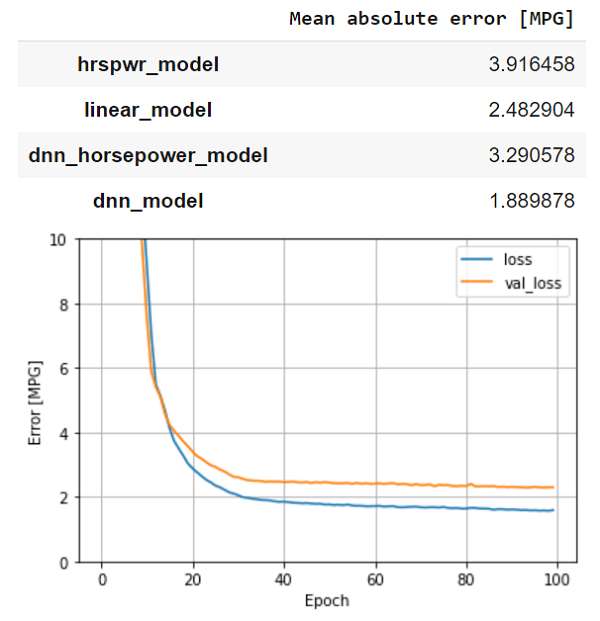如何使用 TensorFlow 在 Auto MPG 資料集上預測 MPG 值的 DNN(深度神經網路)模型?
Tensorflow 是 Google 提供的一個機器學習框架。它是一個開源框架,與 Python 結合使用以實現演算法、深度學習應用程式等等。它用於研究和生產目的。張量是 TensorFlow 中使用的資料結構。它有助於連線流圖中的邊。此流圖稱為“資料流圖”。張量只不過是多維陣列或列表。
可以使用以下程式碼行在 Windows 上安裝“tensorflow”包:
pip install tensorflow
迴歸問題的目標是預測連續或離散變數的輸出,例如價格、機率、是否會下雨等等。
我們使用的資料集稱為“Auto MPG”資料集。它包含 1970 年代和 1980 年代汽車的燃油效率。它包括重量、馬力、排量等屬性。透過此,我們需要預測特定車輛的燃油效率。
我們使用 Google Colaboratory 來執行以下程式碼。Google Colab 或 Colaboratory 幫助透過瀏覽器執行 Python 程式碼,並且無需任何配置即可免費訪問 GPU(圖形處理單元)。Colaboratory 建立在 Jupyter Notebook 之上。以下是程式碼片段:
。
示例
print("Model is being built and compiled")
dnn_model = build_compile_model(normalizer)
print("The statistical summary is displayed ")
dnn_model.summary()
print("The data is being fit to the model")
history = dnn_model.fit(
train_features, train_labels,
validation_split=0.2,
verbose=0, epochs=100)
print("The error versus epoch is visualized")
plot_loss(history)
print("The predictions are being evaluated")
test_results['dnn_model'] = dnn_model.evaluate(test_features, test_labels, verbose=0)
pd.DataFrame(test_results, index=['Mean absolute error [MPG]']).T程式碼來源 - https://www.tensorflow.org/tutorials/keras/regression
輸出


解釋
模型已構建並編譯。
使用“summary”函式顯示計數、均值、中位數等統計值。
此編譯後的模型適合資料。
在控制檯上繪製了步數與預測誤差的關係視覺化圖。
與線性迴歸相比,使用 DNN 更好。

廣告

 資料結構
資料結構 網路
網路 關係型資料庫管理系統
關係型資料庫管理系統 作業系統
作業系統 Java
Java iOS
iOS HTML
HTML CSS
CSS Android
Android Python
Python C 語言程式設計
C 語言程式設計 C++
C++ C#
C# MongoDB
MongoDB MySQL
MySQL Javascript
Javascript PHP
PHP